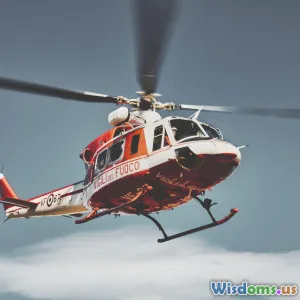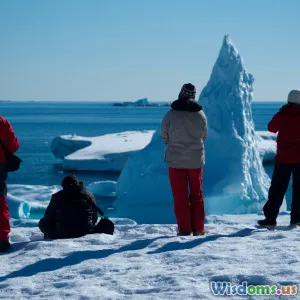
The Cost of Getting Rescued Without Proper Coverage
7 min read Explore the financial pitfalls of rescues without coverage and how to safeguard yourself against unexpected costs. (0 Reviews)
The Cost of Getting Rescued Without Proper Coverage
Imagine this: you’ve set out on a thrilling hiking trip, soaking in breathtaking vistas, when suddenly you injure yourself or get lost. You call for help, and while a rescue team finds you, the soaring bill that arrives afterward shocks you most of all. Getting rescued without the right insurance or membership can cost tens of thousands of dollars, a financial burden many aren’t prepared for.
This article dives deep into why proper rescue coverage matters, the staggering costs involved without it, and how you can avoid turning an adventure into a costly nightmare.
Understanding Rescue Costs: Why They Can Be Astronomical
Emergency rescues, whether on mountains, oceans, or remote wilderness, require highly specialized personnel and equipment. Helicopters, skilled paramedics, search dogs, and coordination technologies add up. Here are key components that drive these costs:
1. Helicopter Extraction
Helicopter rescues can cost anywhere from $5,000 to $20,000 per hour. For instance, in 2020, a helicopter evacuation in Alaska from a remote area reportedly cost nearly $50,000 due to extended flight time and complex maneuvers.
2. Specialized Rescue Teams
Search and rescue teams may include park rangers, volunteers, and professional paramedics trained for technical recoveries, night searches, or water rescues. Paying for their time, equipment, and risk can reach thousands more.
3. Medical Treatment En Route
If the victim needs immediate medical assistance, the rescue often doubles as emergency medical transport, adding hospital or paramedic charges.
Real-World Example
In Canada’s Banff National Park, a hiker with a broken leg was charged over CAD 30,000 for a combination of helicopter extraction and hospital transfer — prompting national debates on rescue cost responsibility.
The Financial Risk of Going Without Rescue Coverage
Many adventurers underestimate the possibility or cost severity of rescue operations.
Surprise Bills Post-Rescue
Without coverage, individuals receive invoices directly covering all rescue expenses, often costing more than a year’s rent or college tuition.
Burden on Family and Insurers
If an individual lacks coverage, family members or personal health policies might bear the load, sometimes disallowing full coverage of rescue expenses.
Impact on Emergency Services
Insufficient coverage means services may be financially strained, leading to political and public pressure to shift costs onto users or taxpayers.
Case in Point
A snowmobiler in Colorado avoided severe shocks by having a $75 wilderness rescue membership but reported that a stranger without coverage was billed over $40,000 for an avalanche rescue nearby.
Forms of Rescue Coverage: What to Consider
To protect yourself financially, it's essential to understand the types of coverage available:
1. Membership Programs
Organizations like the American Alpine Club or Mountain Rescue Association offer memberships that cover search and rescue costs within certain parameters.
2. Travel and Adventure Insurance
Adventure insurance policies including evacuation and rescue clauses provide protection during activities like climbing, skiing, or boating.
3. Health Insurance and Supplemental Rescue Coverage
While health insurance can cover medical costs after rescue, it often does not cover extraction costs. Supplemental rescue coverage fills this gap.
4. Government or Park Service Policies
Some regions operate 'self-pay' rescue frameworks, but others require proof of insurance before permitting certain activities.
How to Avoid Being a Victim of Surprise Rescue Fees
Plan Ahead
Before venturing out, research rescue policies related to your destination and activities. International travelers especially must check their domestic plans’ coverage abroad.
Invest in Comprehensive Insurance
Choose policies with explicit coverage for search and rescue, helicopter evacuation, and medical transport.
Membership Enrollment
Join organizations specializing in rescue coverage if you routinely participate in high-risk outdoor activities.
Stay Updated on Regional Requirements
Some destinations mandate insurance proof to enter, assisting in preventing costly unplanned rescues.
Consider Real-Life Stories
Outdoor enthusiast Dave Armstrong shared on a popular adventuring forum how paying $150 annually for a rescue membership saved him from a $25,000 bill during a backcountry climb.
Conclusion: Teaching Financial Preparedness Through Rescue Coverage
Getting rescued in an emergency is not just a life-saving action; it can be financially transformative. Costs without proper coverage often reach into tens of thousands of dollars, blindsiding unprepared adventurers and travelers alike.
The wealth of real-world examples confirms that proactive investment in rescue coverage, whether via insurance or memberships, is a small price to pay compared to the potential financial fallout. As recreational activities rise worldwide, awareness and preparation about rescue costs are essential for every explorer.
Safeguarding yourself financially ensures that your memories remain exhilarating—not traumatic—and your adventures unforgettable for all the right reasons.
Sources:
- National Search and Rescue Program Reports
- American Alpine Club Rescue Membership Data
- CBC News coverage on Canadian rescue bill cases
- Personal accounts from outdoor enthusiasts documented in adventure forums
Rate the Post
User Reviews
Popular Posts














